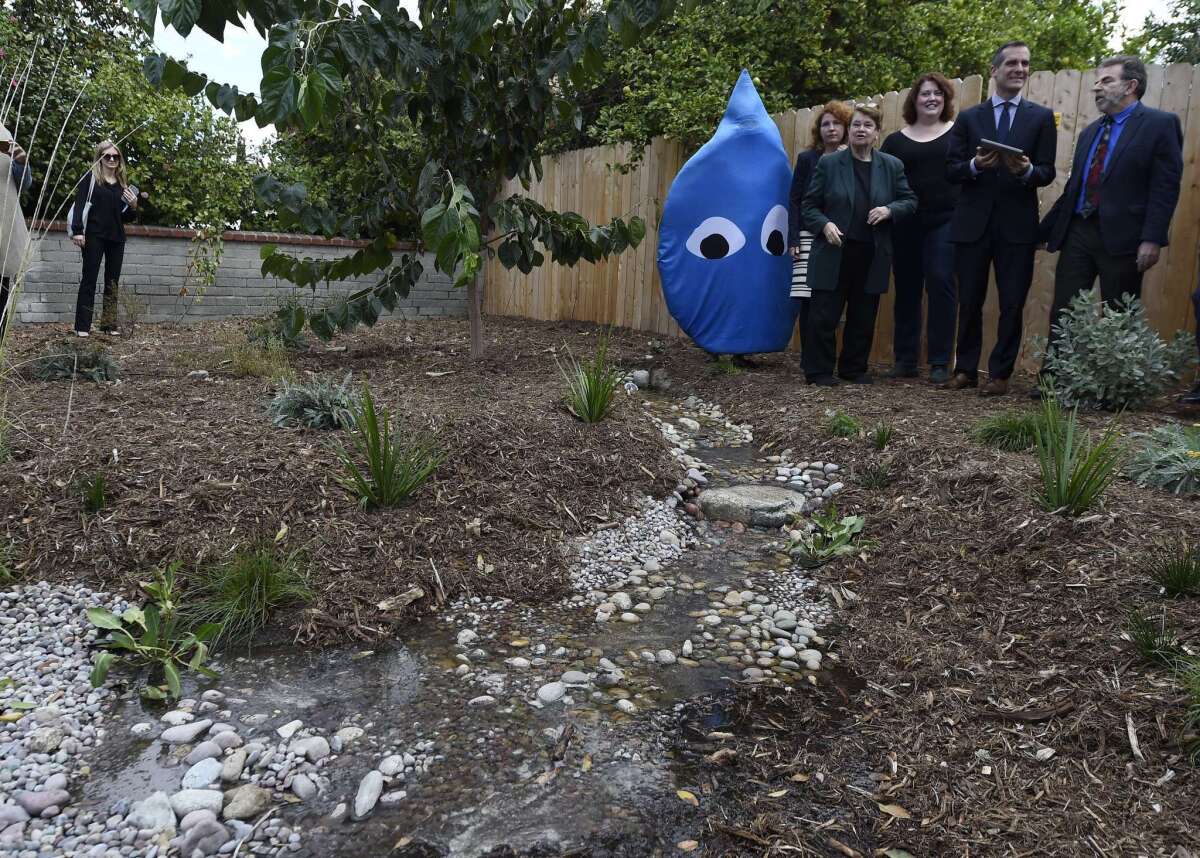Op-Ed: California must capture water, not waste it

L.A. County Supervisor Sheila Kuehl, Mayor Eric Garcetti and conservation advocate Andy Lipkis of TreePeople stand with others and watch as water is released electronically from a newly installed 500 liter water cistern into a “rain garden” for replenishing groundwater on Nov. 4.
We don’t know for sure whether the El Niño we face this winter will be a drought buster or a bust. But we had better prepare for a lot of rain and the potential flooding, landslides and disruptions we know especially heavy winter storms can bring to California. At the same time, we need to look past the coming
El Niño at the long-term changes in our weather patterns, as climate change poses new challenges to water managers, planners, utilities and, indeed, all of us.
For the last century, California has had two key strategies for dealing with its winter wet season: Build big reservoirs on the rivers draining the Sierra Nevada to capture and store seasonal runoff and floodwater, and rely on mountain snowpack to build up in the winter and melt slowly over the spring and early summer. That approach brought great benefits to us and helped tame California’s naturally variable weather.
Every year, hundreds of billions of gallons of storm water wash into Santa Monica Bay, Long Beach Harbor and the San Francisco Bay.
But the era of big dams is over. We’ve built on all the decent dam sites (and some not-so-decent ones), federal money for Western water projects has dried up and the environmental damage caused by dams is now better known. As a result, it is unlikely that more than one or two new big dams will be built in California, and they would do little to expand the amount of water we can actually use.
As for the snowpack, despite El Niño’s potential to drop a lot of snow in the Sierra, as the climate warms, future snowpack will be smaller and it will melt faster, putting more strain on our water supply.
California’s water problems require a multitude of responses. We must reduce inefficiency and waste, and we must find new sources of water. One important approach is to improve our ability to capture, treat and use urban storm water, especially in the Los Angeles and San Francisco Bay areas.
As we have paved our cities, covering the land with impervious concrete and asphalt, less and less rain is recharging urban groundwater; it’s running off all those hard surfaces into storm sewers and out to the ocean. Every year, hundreds of billions of gallons of storm water wash into Santa Monica Bay, Long Beach Harbor and the San Francisco Bay. Even one inch of rain in Los Angeles can generate more than 10 billion gallons of runoff.
It’s possible to capture quite a bit of that water. We will have to repave streets and parking lots with porous materials so that rain can percolate into the ground and recharge aquifers. Parks, open spaces and urban watersheds must be reconfigured with the same goal in mind. And homeowners need incentives to capture rainfall too, for use on their gardens and landscapes.
Such strategies have benefits beyond increasing local water supplies. They can reduce urban flooding, restore the health of local waterways such as the Los Angeles River and reduce pollution flowing into our oceans and onto our beaches. They can also be adapted for use in agricultural areas. Letting winter storms temporarily flood farmland adjacent to rivers would accelerate the recharge of seriously overpumped groundwater basins in the Central Valley.
The Water Replenishment District of Southern California, which manages groundwater in Los Angeles County, has identified thousands of acres where capturing storm water for groundwater recharge is possible. This could provide tens of thousands of acre-feet of “new” water for the L.A. Basin, reducing the region’s dependence on increasingly scarce and unreliable imported water.
There are specific projects that cities everywhere are undertaking to better manage storm water. In Chicago’s Green Alley program, porous concrete allows storm water to drain into the ground, reducing sewer overflows and minimizing local flooding. Philadelphia businesses have installed roof gardens that absorb as much as half the rain that falls on them; the businesses get a tax credit that helps cover part of the cost.
Locally, the L.A. County Flood Control District, the Department of Water and Power, the nonprofit group TreePeople and the Bureau of Sanitation have launched a pilot program that will retrofit 10 homes with rain-capturing roofs, water storage cisterns and specially designed rain gardens to take full advantage of whatever precipitation falls.
A 2014 study by the Pacific Institute and the Natural Resources Defense Council estimated that storm water capture in urbanized Southern California and the San Francisco Bay region could increase California’s water supplies overall by 420,000 to 630,000 acre-feet per year — as much water as is used annually by the city of Los Angeles — while also reducing pollution flowing into the oceans.
There is no single solution to California’s water challenges. In the face of unavoidable climate changes and growing competition for limited water, the best strategies will be those that improve the state’s water resilience on many fronts. More emphasis on local efforts that capture water through permeable hardscape, new local ordinances, homeowner incentives and smart infrastructure can help us take advantage of the times when it rains and when it pours.
Peter H. Gleick is president and co-founder of the Pacific Institute in Oakland.
Follow the Opinion section on Twitter @latimesopinion and Facebook
More to Read
A cure for the common opinion
Get thought-provoking perspectives with our weekly newsletter.
You may occasionally receive promotional content from the Los Angeles Times.










